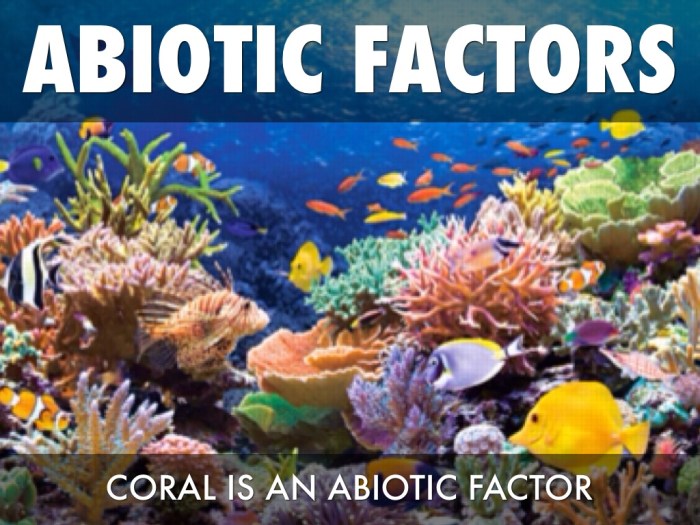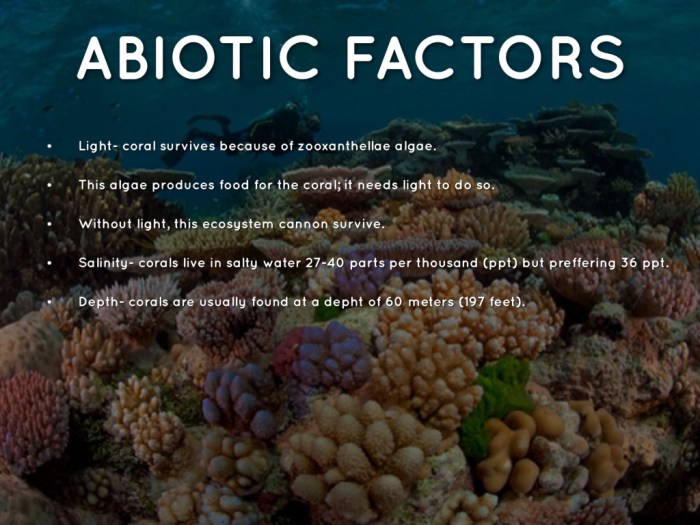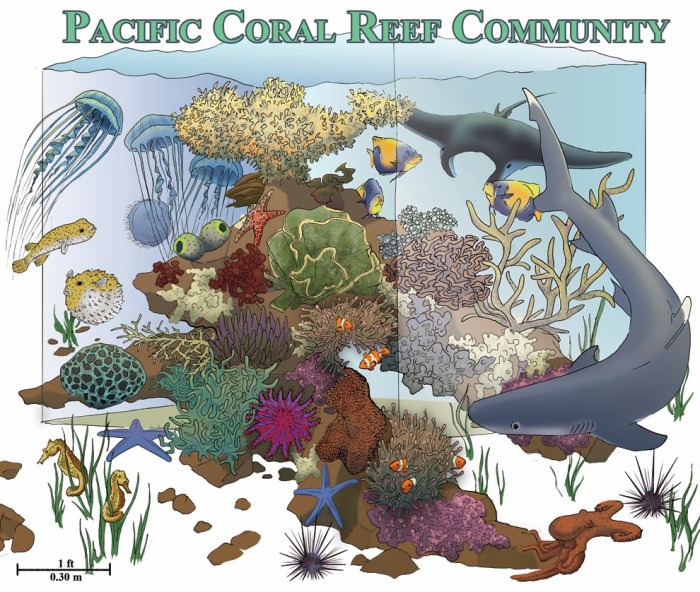Delving into the realm of coral reefs 1 abiotic factors, we embark on a captivating journey to unravel the intricate web of physical and chemical forces that mold these vibrant underwater landscapes. These factors, like the symphony of an orchestra, play a crucial role in the health and survival of coral reefs, shaping their growth, morphology, and resilience.
From the dance of sunlight and temperature to the rhythm of water flow and salinity, each abiotic factor leaves an imprint on the tapestry of coral reefs. Understanding their interplay is paramount in safeguarding these precious ecosystems, ensuring their continued existence for generations to come.
Coral Reefs
Coral reefs are vibrant underwater ecosystems composed of colonies of tiny marine invertebrates called corals. These reefs are not only beautiful but also ecologically crucial, supporting a vast array of marine life.
Types of Coral Reefs
Coral reefs exhibit diversity in their structure and composition, leading to various classifications. Three primary types of coral reefs are:
- Fringing Reefs:These reefs are directly attached to the shoreline, creating a shallow and narrow underwater ecosystem.
- Barrier Reefs:These reefs are separated from the mainland by a lagoon or channel, often forming a protective barrier against waves.
- Atolls:These reefs are circular or horseshoe-shaped structures that encircle a lagoon, typically found in the open ocean.
Distribution of Coral Reefs
Coral reefs are predominantly found in warm, tropical waters, primarily within the latitudes of 30 degrees north and south of the equator. The distribution of reefs is influenced by various factors, including water temperature, sunlight availability, and nutrient levels.
Abiotic Factors Influencing Coral Reefs

Abiotic factors play a critical role in shaping the health and distribution of coral reefs. These factors include light intensity and quality, temperature, salinity, pH, water flow, and wave action. Understanding the influence of these factors is essential for reef conservation and management.
Light Intensity and Quality
Light intensity and quality are crucial for coral growth and photosynthesis. Corals require specific wavelengths of light for photosynthesis, and the availability of these wavelengths can vary depending on water depth, turbidity, and the presence of shading organisms. Optimal light conditions promote coral growth and reproduction, while low light levels can hinder coral health.
Temperature
Temperature is another important factor that affects coral reefs. Corals have a narrow temperature tolerance range, and prolonged exposure to temperatures outside this range can lead to coral bleaching. Bleaching occurs when corals expel their symbiotic algae, which provide them with nutrients and color.
Bleached corals are more susceptible to disease and death, and severe bleaching events can cause widespread reef damage.
Salinity and pH
Salinity and pH are also important abiotic factors for coral reefs. Corals prefer slightly alkaline water with a salinity range of 32-35 parts per thousand. Deviations from these optimal conditions can stress corals and make them more vulnerable to disease.
Water Flow and Wave Action
Water flow and wave action influence the morphology and growth patterns of corals. Strong water flow can remove sediment and nutrients from the reef, while gentle wave action can provide oxygen and food for corals. However, excessive wave action can damage coral structures and hinder their growth.
Physical Abiotic Factors: Coral Reefs 1 Abiotic Factors

Physical abiotic factors significantly influence the health and composition of coral reef ecosystems. These factors include sedimentation, turbidity, coastal development, pollution, storms, and hurricanes.
Sedimentation and Turbidity, Coral reefs 1 abiotic factors
Sedimentation and turbidity refer to the presence of suspended particles in the water column. Excessive sedimentation can smother corals, block sunlight, and reduce water quality. Turbidity, caused by fine particles like silt and clay, can also impair coral growth and photosynthesis.
Coral reefs rely on various abiotic factors like sunlight, temperature, and salinity. Understanding these factors is crucial for reef conservation. Similar to the dedication of the angels of truth kappa delta , researchers strive to protect and preserve these delicate ecosystems by unraveling the complexities of abiotic factors that shape coral reef health.
Coastal Development and Pollution
Coastal development and pollution pose significant threats to coral reefs. Construction, dredging, and runoff from land-based activities can introduce pollutants, sediments, and nutrients into the marine environment, harming coral health.
Storms and Hurricanes
Storms and hurricanes can have both destructive and beneficial effects on coral reefs. While intense storms can cause physical damage to corals, they can also remove dead or weakened corals, creating space for new growth. Hurricanes can also bring nutrient-rich waters to reefs, stimulating coral growth.
Chemical Abiotic Factors

Chemical factors play a crucial role in the health and growth of coral reefs. These factors include dissolved oxygen, carbon dioxide, nutrient levels, and the presence of heavy metals and toxins.
Dissolved Oxygen and Carbon Dioxide
Dissolved oxygen is essential for coral respiration, as corals use oxygen to break down food and generate energy. Carbon dioxide is also important for corals, as it is used to build their calcium carbonate skeletons.
Nutrient Enrichment and Eutrophication
Nutrient enrichment, such as from agricultural runoff or sewage, can lead to eutrophication, which is an increase in nutrient levels in the water. Eutrophication can cause algal blooms, which can block sunlight from reaching corals and disrupt their symbiotic relationship with algae.
Heavy Metals and Toxins
Heavy metals and toxins, such as lead, mercury, and pesticides, can be harmful to corals. These substances can accumulate in coral tissues and damage their cells, leading to reduced growth, bleaching, and even death.
Interconnections between Abiotic Factors

Abiotic factors in coral reef ecosystems are interconnected, influencing each other and collectively shaping the health and biodiversity of these fragile environments. Understanding these interconnections is crucial for comprehending the functioning and vulnerability of coral reefs.
Limiting Factors
Limiting factors are environmental conditions that restrict the growth, survival, or distribution of organisms. In coral reefs, various abiotic factors can act as limiting factors, including light availability, temperature, salinity, and nutrient levels. When a limiting factor reaches a critical threshold, it can hinder coral growth, reproduction, or survival, potentially leading to reef degradation or even collapse.
Potential Consequences of Climate Change
Climate change poses significant threats to coral reef ecosystems by altering the abiotic conditions they rely on. Rising sea temperatures, ocean acidification, and increased storm frequency and intensity can disrupt the delicate balance of these factors, leading to coral bleaching, disease outbreaks, and reduced growth rates.
These changes can have devastating consequences for coral reef biodiversity, ecosystem services, and the livelihoods of communities that depend on them.
FAQ Insights
What are the key abiotic factors that influence coral reef growth?
Light intensity and quality, temperature, salinity, pH, water flow, and wave action are among the primary abiotic factors that shape coral reef development.
How does sedimentation impact coral reefs?
Excessive sedimentation can smother corals, block sunlight, and disrupt their feeding mechanisms, potentially leading to coral bleaching and death.
What is the role of nutrient enrichment in coral reef health?
While some nutrients are essential for coral growth, excessive nutrient enrichment can lead to eutrophication, promoting harmful algal blooms that compete with corals for resources.